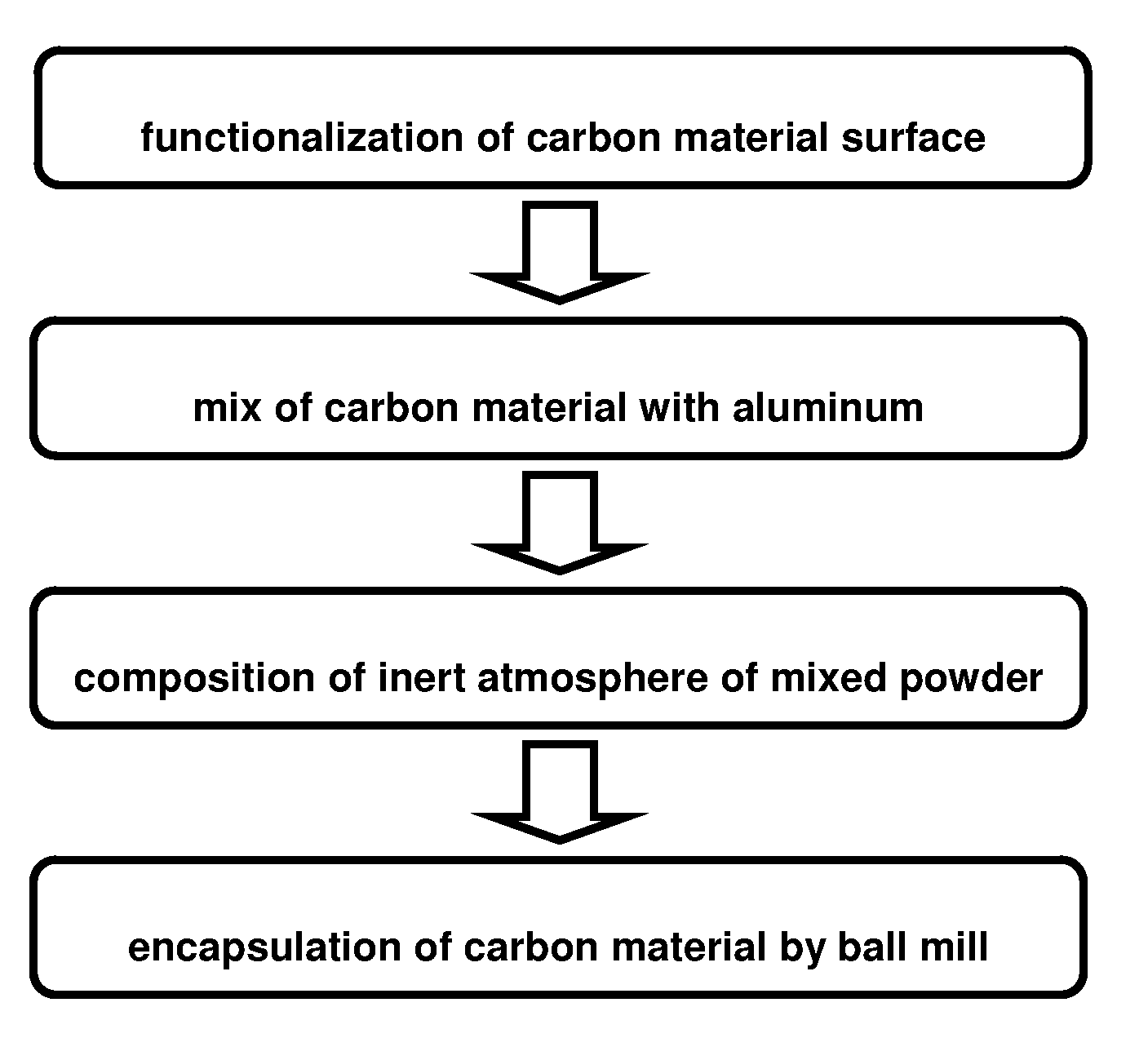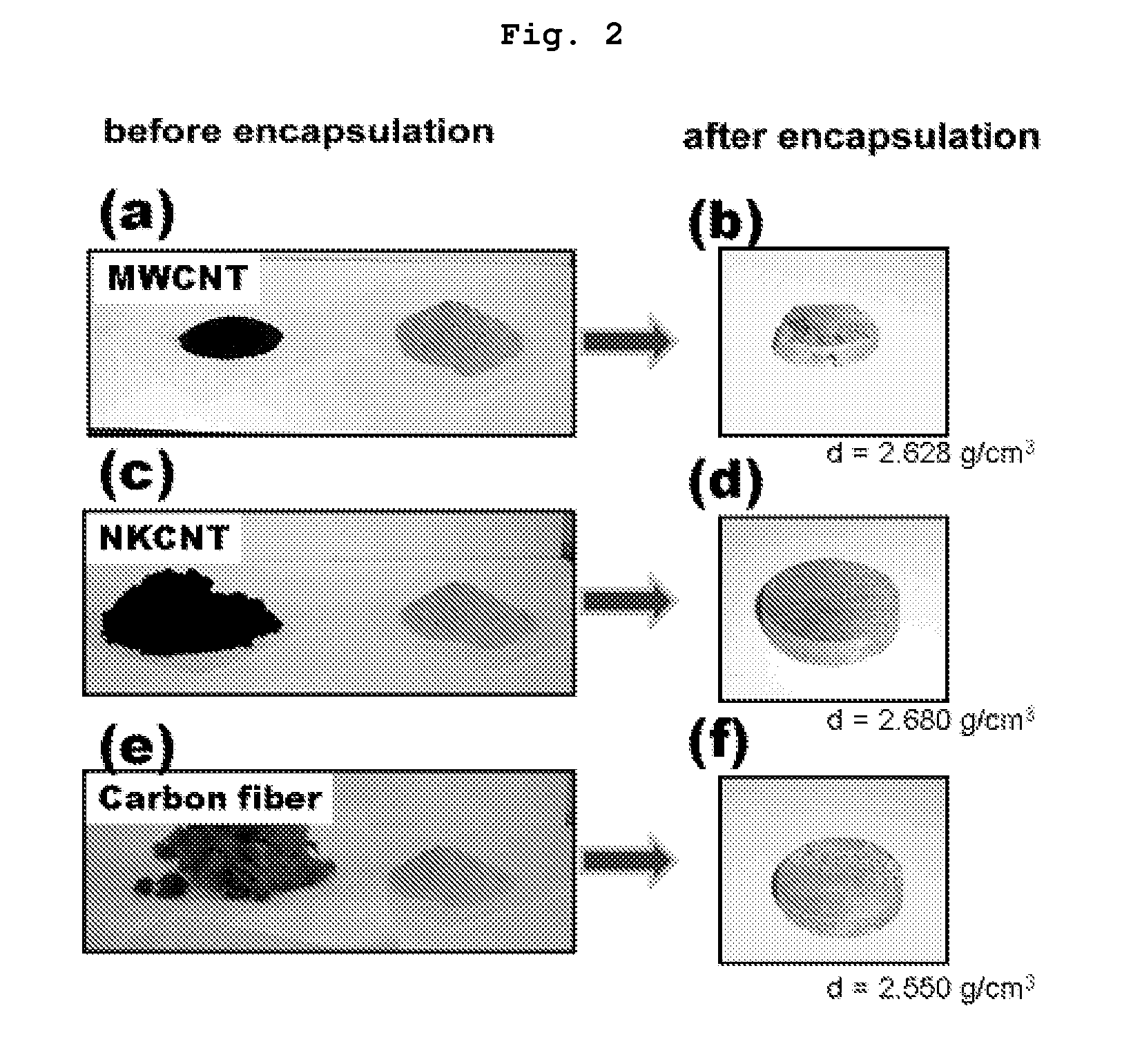Encapsulation of carbon material within aluminum
a carbon material and aluminum technology, applied in the field of encapsulation of carbon materials within aluminum, can solve the problems of difficult uniform dispersion of aluminum matrix, difficult to overcome problems, and excessive cost, and achieve the effects of improving effect, high physical properties, and high strength
- Summary
- Abstract
- Description
- Claims
- Application Information
AI Technical Summary
Benefits of technology
Problems solved by technology
Method used
Image
Examples
example 1
Encapsulation of a Carbon Material within Aluminum
[0041]An embodiment of the present invention is described in FIG. 1. As carbon materials, a multi-walled carbon nanotube (ILJIN Nanotech, CM95), an NK carbon nanotube (nanokarbon, hellow CNT 75), and a carbon fiber (Toray—Japan, T 300) were used. Herein, the multi-walled carbon nanotube and the NK carbon nanotube had diameters of 10 to 20 nm, and 40 to 60 nm, and lengths of 10 to 20 μm, and 20 μm, respectively.
[0042]1-1. Functionalization of a Carbon Material by Acid Treatment
[0043]The carbon nanotube was functionalized by an ultrasonic reaction in a water tank type reactor containing 70% nitric acid (HNO3) for 10 minutes to 3 hours. As the NK carbon nanotube, a functionalized product was used. The carbon fiber was functionalized by an ultrasonic reaction in a 1:1 mixture of sulfuric acid (H2SO4) and nitric acid (HNO3) for 2 hours.
[0044]1-2. Functionalization of a Carbon Material by Microwave Treatment
[0045]In a method of functionali...
example 2
Observation of a Change in Colors After Encapsulation of a Carbon Material within Aluminum
[0050]A change in colors before / after encapsulation of a carbon material within aluminum was taken by a digital camera (Nikon, koolpix-3700).
[0051]FIG. 2a is a photograph of a multi-walled carbon nanotube before aluminum encapsulation, and shows actual volumes before encapsulation of the multi-walled carbon nanotube within aluminum. FIG. 2b is a photograph of an aluminum-encapsulated multi-walled carbon nanotube. Compared to FIG. 2a before the encapsulation, the aluminum-encapsulated multi-walled carbon nanotube shows an apparent color of silver-white, which is the same as that of aluminum. Accordingly, it is determined that the multi-walled carbon nanotube was completely aluminum-encapsulated.
[0052]FIG. 2c is a photograph of an NK carbon nanotube before aluminum encapsulation. The NK carbon nanotube is a kind of multi-walled carbon nanotube, and has a thicker diameter than a general multi-wall...
example 3
Electron Microscopic Photograph After Encapsulation of a Carbon Material within Aluminum
[0054]FIG. 3 illustrates electron microscopic photographs (JEOL, JSM7000F) of a multi-walled carbon nanotube after aluminum encapsulation. FIG. 3a is a photograph of the surface of an aluminum-encapsulated multi-walled carbon nanotube, which was taken by an electron microscope (×10,000). FIG. 3b is an electron microscopic photograph of the same portion as FIG. 3a (×30,000). FIG. 3c is an electron microscopic photograph of the multi-walled carbon nanotube before the aluminum encapsulation (×30,000). Under the same magnification (×30,000), comparing FIG. 3c, that is, a photograph before the aluminum encapsulation, and FIG. 3b, that is, a photograph after the aluminum encapsulation, it is determined that in FIG. 3c, a multi-walled carbon nanotube was not observed. Also, since the material observed in FIG. 3b was found to be aluminum according to analysis on elements, it is determined that the multi-...
PUM
| Property | Measurement | Unit |
|---|---|---|
| electric power | aaaaa | aaaaa |
| length | aaaaa | aaaaa |
| diameter | aaaaa | aaaaa |
Abstract
Description
Claims
Application Information
 Login to View More
Login to View More - R&D
- Intellectual Property
- Life Sciences
- Materials
- Tech Scout
- Unparalleled Data Quality
- Higher Quality Content
- 60% Fewer Hallucinations
Browse by: Latest US Patents, China's latest patents, Technical Efficacy Thesaurus, Application Domain, Technology Topic, Popular Technical Reports.
© 2025 PatSnap. All rights reserved.Legal|Privacy policy|Modern Slavery Act Transparency Statement|Sitemap|About US| Contact US: help@patsnap.com



